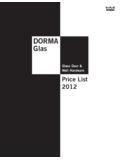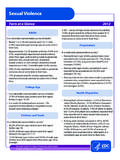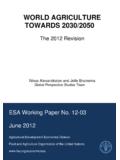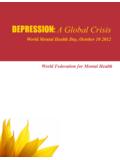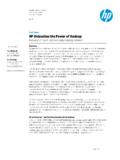Transcription of International consensus guidelines 2012 for the …
1 Pancreatology 12 ( 2012 ) 183e197. Contents lists available at SciVerse ScienceDirect Pancreatology journal homepage: Review article International consensus guidelines 2012 for the management of IPMN and MCN of the pancreas Masao Tanaka a, *, Carlos Fern ndez-del Castillo b, Volkan Adsay c, Suresh Chari d, Massimo Falconi e, Jin-Young Jang f, Wataru Kimura g, Philippe Levy h, Martha Bishop Pitman i, C. Max Schmidt j, Michio Shimizu k, Christopher L. Wolfgang l, Koji Yamaguchi m, Kenji Yamao n a Department of Surgery and Oncology, Graduate School of Medical Sciences, Kyushu University, Fukuoka 812-8582, Japan b Pancreas and Biliary Surgery Program, Massachusetts General Hospital, Harvard Medical School, Boston, MA, USA. c Department of Anatomic Pathology, Emory University Hospital, Atlanta, GA, USA. d Pancreas Interest Group, Division of Gastroenterology and Hepatology, Mayo Clinic, Rochester, MN, USA.
2 E Chirurgia B, Dipartimento di Chirurgia Policlinico Rossi , Verona, Italy f Division of Hepatobiliary-Pancreatic Surgery, Department of Surgery, Seoul National University College of Medicine, Seoul, South Korea g First Department of Surgery, Yamagata University, Yamagata, Japan h P le des Maladies de l'Appareil Digestif, Service de Gastroent rologie-Pancr atologie, Hopital Beaujon, Clichy Cedex, France i Department of Pathology, Massachusetts General Hospital, Harvard Medical School, Boston, MA, USA. j Department of Surgery, Indiana University, Indianapolis, IN, USA. k Department of Pathology, Saitama Medical University, International Medical Center, Saitama, Japan l Cameron Division of Surgical Oncology and The Sol Goldman Pancreatic Cancer Research Center, Department of Surgery, Johns Hopkins University, Baltimore, MD, USA. m Department of Surgery I, University of Occupational and Environmental Health, Fukuoka, Japan n Aichi Cancer Center Hospital, Aichi, Japan a r t i c l e i n f o a b s t r a c t Article history: The International consensus guidelines for management of intraductal papillary mucinous neoplasm and Received 7 December 2011 mucinous cystic neoplasm of the pancreas established in 2006 have increased awareness and improved Received in revised form the management of these entities.
3 During the subsequent 5 years, a considerable amount of information 6 April 2012 . has been added to the literature. Based on a consensus symposium held during the 14th meeting of the Accepted 8 April 2012 . International Association of Pancreatology in Fukuoka, Japan, in 2010, the working group has generated new guidelines . Since the levels of evidence for all items addressed in these guidelines are low, being 4 or 5, we still have to designate them consensus , rather than evidence-based , guidelines . To simplify the Keywords: International guidelines entire guidelines , we have adopted a statement format that differs from the 2006 guidelines , although the Intraductal papillary mucinous neoplasm headings are similar to the previous guidelines , , classi cation, investigation, indications for and Mucinous cystic neoplasm methods of resection and other treatments, histological aspects, and methods of follow-up.
4 The present guidelines include recent information and recommendations based on our current understanding, and highlight issues that remain controversial and areas where further research is required. Copyright ! 2012 , IAP and EPC. Published by Elsevier India, a division of Reed Elsevier India Pvt. Ltd. All rights reserved. 1. Introduction new information has been obtained regarding endoscopic ultrasonography-guided ne-needle aspiration (EUS-FNA) of the Since the publication of the International consensus guidelines cyst contents, the indications for resection of branch duct IPMN. for management of intraductal papillary mucinous neoplasm (BD-IPMN) have changed from rather early resection to more (IPMN) and mucinous cystic neoplasm (MCN) of the pancreas in deliberate observation, and some reports have documented the 2006 [1], these entities have been drawing increasing attention.
5 As occurrence of concomitant pancreatic ductal adenocarcinoma a consequence, a considerable amount of information has been (PDAC) in patients with BD-IPMN. All this new knowledge makes an added to the literature during the subsequent 5 years. In particular, update of the guidelines imperative. During the 14th meeting of the International Association of Pancreatology (IAP) held in Fukuoka, Japan, in 2010, we arranged a symposium where recent progress in * Corresponding author. Tel.: 81 92 642 5437; fax: 81 92 642 5457. preoperative diagnosis and management was presented. All the E-mail address: (M. Tanaka). speakers in the symposium, including eight initial members and six 1424-3903/$ e see front matter Copyright ! 2012 , IAP and EPC. Published by Elsevier India, a division of Reed Elsevier India Pvt. Ltd. All rights reserved. 184 M. Tanaka et al.
6 / Pancreatology 12 ( 2012 ) 183e197. new members of the working group, have generated new guide- Table 1 (continued). lines based on an elaborate list of items to be addressed. Since the 5. Histological Aspects levels of evidence for all items addressed in these guidelines are 5a. The type of invasive carcinoma, colloid versus tubular, has major low, being 4 or 5, we still have to designate them consensus , prognostic implications and should be part of the reporting of IPMNs, with rather than evidence-based , guidelines . We have made a series of colloid carcinomas being characterized by intestinal differentiation and recommendations for all items in Table 1. However, since the grades a better prognosis than tubular carcinomas. 5b. Instead of minimally invasive carcinoma derived from IPMN or MCN, it of the recommendations are low, we have avoided repetition of would be more appropriate to stage invasive carcinomas with the grade C in almost all of the items.
7 Conventional staging protocols and further substage the T1 category into T1a All the authors contributed equally to the guidelines . M. Tanaka (# cm), T1b (> cm and #1 cm), and T1c (1e2 cm). chaired and C. Fernandez-del Castillo co-chaired this working 5c. The histologic subtypes of IPMN have clinicopathologic signi cance. The group of the IAP, and these two authors played a major role in the gastric type is typically low grade, with only a small percentage developing into carcinoma. However, if a carcinoma does develop, it is usually of the preparation of the manuscript. The remaining authors are listed in tubular type and aggressive. Large intestinal-type IPMNs can have invasive alphabetical order. carcinoma of the colloid type with indolent behavior. 5d. If clear high-grade dysplasia or invasive carcinoma is present at the margin Table 1 by frozen section analysis, further resection is warranted.
8 All patients should Summary of recommendations. be informed preoperatively about the possibility of total pancreatectomy. Moderate-grade or low-grade dysplasia may not require any further therapy. 1. Classi cation 5e. Pathologists should make every attempt to classify the lesion as MD-IPMN. 1a. The threshold of MPD dilation, segmental or diffuse, for characterization of or BD-IPMN, being careful to identify the MPD as precisely as possible when MD-IPMN has been lowered to >5 mm without other causes of obstruction, processing the specimen. thereby increasing the sensitivity for radiologic diagnosis without losing 5f. A distinction between PDAC derived from an IPMN and PDAC concomitant speci city. MPD dilation of 5e9 mm is considered a worrisome feature , with an IPMN is proposed with regard to the topological relationship and while an MPD diameter of "10 mm is one of the high-risk stigmata.
9 Histological transition, although the distinction sometimes remains 1b. The de nition of malignancy of IPMNs and MCNs has been variable, undetermined. hampering comparisons of data. We recommend abandoning the term carcinoma in situ in favor of high-grade dysplasia, reserving the descriptor 6. Methods of follow-up of malignancy for invasive carcinoma, as outlined in the recent WHO 6a. Patients without high-risk stigmata should undergo MRI/MRCP (or CT). classi cation. after a short interval (3e6 months) to establish the stability, and then annual history/physical examination, MRI/MRCP (or CT) and serologic marker 2. Investigation surveillance. Short interval surveillance (3e9 months) should be considered 2a. CT or MRI with MRCP is recommended for a cyst of "1 cm to check for for patients whose IPMN progresses toward high-risk stigmata and patients high-risk stigmata , including enhanced solid component and MPD size of with a family history of hereditary PDAC.
10 Some investigators continue "10 mm, or worrisome features , including cyst of "3 cm, thickened surveillance at short intervals owing to concern over the development of enhanced cyst walls, non-enhanced mural nodules, MPD size of 5e9 mm, distinct PDAC. abrupt change in the MPD caliber with distal pancreatic atrophy, and 6b. Non-invasive MCNs require no surveillance after resection. IPMNs need lymphadenopathy. All cysts with worrisome features and cysts of >3 cm surveillance based on the resection margin status. If there are no residual without worrisome features should undergo EUS, and all cysts with high- lesions, repeat examinations at 2 and 5 years may be reasonable. The aspect risk stigmata should be resected. If no worrisome features are present, no of whether a margin with moderate-grade dysplasia increases recurrence is further initial work-up is recommended, although surveillance is still unknown.
